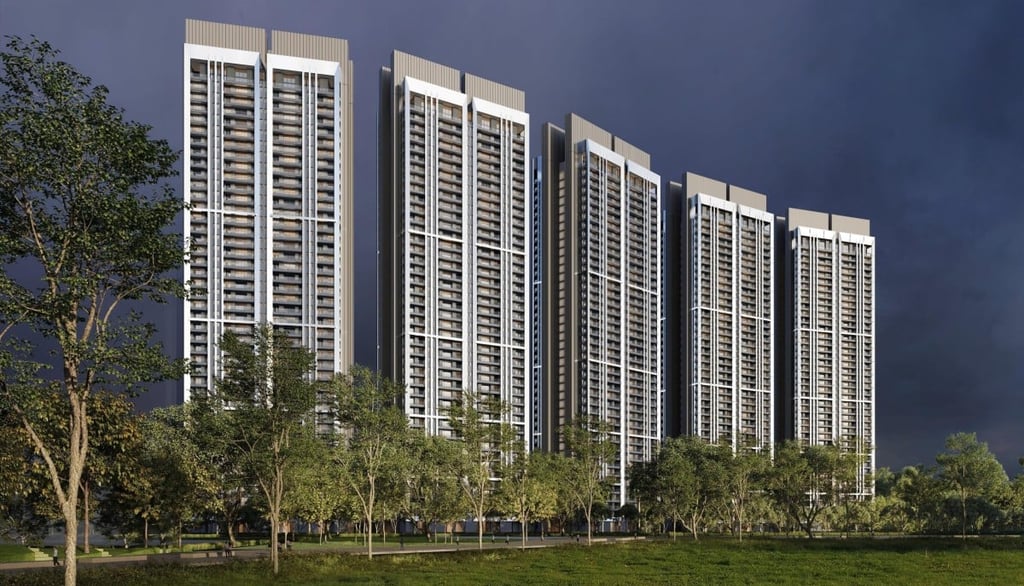India’s luxury property market boom
Thriving luxury housing market signals shift in buyer behaviour seeking long-term value, but short-term bumps likely, analysts say


India’s luxury property market boom has ‘no plateau in sight’ – is it sustainable?
Thriving luxury housing market signals shift in buyer behaviour seeking long-term value, but short-term bumps likely, analysts say


India’s luxury property market boom has ‘no plateau in sight’ – is it sustainable?
Thriving luxury housing market signals shift in buyer behaviour seeking long-term value, but short-term bumps likely, analysts say
When Indian property developer DLF launched a housing project in Gurgaon on the outskirts of capital New Delhi last month, all the flats sold out within a week despite a minimum price tag of more than US$1 million – a figure that would have daunted most buyers until recently.
The successful sale of the project called DLF Privana North in Gurugram followed two others over the 116-acre (47-hectare) residential development, DLF Privana South and DLF Privana West, each of which were sold out in 72 hours in January and May last year respectively.
The benchmark set by India’s largest property developer has seen several others such as Godrej, Emaar and Experion trooping in with launches of several luxury flats at similar prices.
A mix of volatile geopolitical tensions – which have driven overseas Indians to buy into reputable residential properties in their home country – combined with domestic entrepreneurial and professionals’ wealth has ushered in a new genre of housing.
The sale of such expensive homes has caused concern among certain quarters over whether the trend is sustainable.
“There is no indication of a slowdown in the luxury housing market,” said Aakash Ohri, joint managing director and chief business officer at DLF Home Developers Ltd, highlighting the consumer response to the Privana North project which sold for US$1.3 billion.
“This performance signals a shift in buyer behaviour, with customers increasingly seeking long-term value, future-ready infrastructure, and master-planned ecosystems.”
The company is planning more luxury housing projects such as Phase 2 of The Dahlias in Gurugram and a premium offering in Andheri West, Mumbai, as part of its growth strategy, according to Ohri.
“There is no plateau in sight. We planned to launch projects worth over 17,000 crore [170 billion Indian rupees, or US$2 billion] in financial year 2026, capitalising on sustained demand in the luxury segment,” he added.
Housing projects come with amenities such as cafes, lounges, dry cleaning kiosks and hobby corners, with an emphasis on privacy for each flat owner.
Ohri noted that overseas Indians were drawn to the potential for capital appreciation and rental value, as well as lifestyles within a gated and well-planned community.
Indians living abroad accounted for between 25 and 28 per cent of the sales for the Privana series projects, he said, adding that these included buyers from the United States, Singapore, the Middle East, the United Kingdom, Canada, Australia and Indonesia.
Experts say there are early signs that luxury housing may experience short-term bumps.
“Yes, there are some concerns about over-enthusiastic supply,” said Prashant Thakur, regional director and head of research and advisory at property consultancy Anarock group.
The company’s data showed that in the National Capital Region – an economic and urban planning region centred around Delhi – a whopping 82 per cent new supply in the second quarter of this year was added in the luxury segment, which he said was priced above 15 million rupees.
In India’s IT hub in the southern city of Bengaluru, about 92 per cent of the new supply was in the premium and luxury segments, priced at 8 million Indian rupees onwards, he said.
“This may be more than the market can absorb over the short term,” Thakur said.
“There are indications of a gradual slowing down in absorption of luxury homes. However, this is largely attributable to the uncertain global economic environment, which also impacts our stock markets and therefore HNI [high-net-worth individuals] profits. We expect the situation to revive once these factors stabilise,” he added.
India’s luxury housing boom has also partly been fuelled by a rise in entrepreneurial wealth, with several digital enterprises – ranging from food delivery services to cosmetic retailing – attracting institutional investments, including from abroad.
Consequently, India has seen a rise in its billionaire population, with a total of 284 billionaires in 2025, up from 271 in 2024, according to a March report in the Hindu newspaper.
When Indian property developer DLF launched a housing project in Gurgaon on the outskirts of capital New Delhi last month, all the flats sold out within a week despite a minimum price tag of more than US$1 million – a figure that would have daunted most buyers until recently.
The successful sale of the project called DLF Privana North in Gurugram followed two others over the 116-acre (47-hectare) residential development, DLF Privana South and DLF Privana West, each of which were sold out in 72 hours in January and May last year respectively.
The benchmark set by India’s largest property developer has seen several others such as Godrej, Emaar and Experion trooping in with launches of several luxury flats at similar prices.
A mix of volatile geopolitical tensions – which have driven overseas Indians to buy into reputable residential properties in their home country – combined with domestic entrepreneurial and professionals’ wealth has ushered in a new genre of housing.
The sale of such expensive homes has caused concern among certain quarters over whether the trend is sustainable.
“There is no indication of a slowdown in the luxury housing market,” said Aakash Ohri, joint managing director and chief business officer at DLF Home Developers Ltd, highlighting the consumer response to the Privana North project which sold for US$1.3 billion.
“This performance signals a shift in buyer behaviour, with customers increasingly seeking long-term value, future-ready infrastructure, and master-planned ecosystems.”
The company is planning more luxury housing projects such as Phase 2 of The Dahlias in Gurugram and a premium offering in Andheri West, Mumbai, as part of its growth strategy, according to Ohri.
“There is no plateau in sight. We planned to launch projects worth over 17,000 crore [170 billion Indian rupees, or US$2 billion] in financial year 2026, capitalising on sustained demand in the luxury segment,” he added.
Housing projects come with amenities such as cafes, lounges, dry cleaning kiosks and hobby corners, with an emphasis on privacy for each flat owner.
Ohri noted that overseas Indians were drawn to the potential for capital appreciation and rental value, as well as lifestyles within a gated and well-planned community.
Indians living abroad accounted for between 25 and 28 per cent of the sales for the Privana series projects, he said, adding that these included buyers from the United States, Singapore, the Middle East, the United Kingdom, Canada, Australia and Indonesia.
Experts say there are early signs that luxury housing may experience short-term bumps.
“Yes, there are some concerns about over-enthusiastic supply,” said Prashant Thakur, regional director and head of research and advisory at property consultancy Anarock group.
The company’s data showed that in the National Capital Region – an economic and urban planning region centred around Delhi – a whopping 82 per cent new supply in the second quarter of this year was added in the luxury segment, which he said was priced above 15 million rupees.
In India’s IT hub in the southern city of Bengaluru, about 92 per cent of the new supply was in the premium and luxury segments, priced at 8 million Indian rupees onwards, he said.
“This may be more than the market can absorb over the short term,” Thakur said.
“There are indications of a gradual slowing down in absorption of luxury homes. However, this is largely attributable to the uncertain global economic environment, which also impacts our stock markets and therefore HNI [high-net-worth individuals] profits. We expect the situation to revive once these factors stabilise,” he added.
India’s luxury housing boom has also partly been fuelled by a rise in entrepreneurial wealth, with several digital enterprises – ranging from food delivery services to cosmetic retailing – attracting institutional investments, including from abroad.
Consequently, India has seen a rise in its billionaire population, with a total of 284 billionaires in 2025, up from 271 in 2024, according to a March report in the Hindu newspaper.
